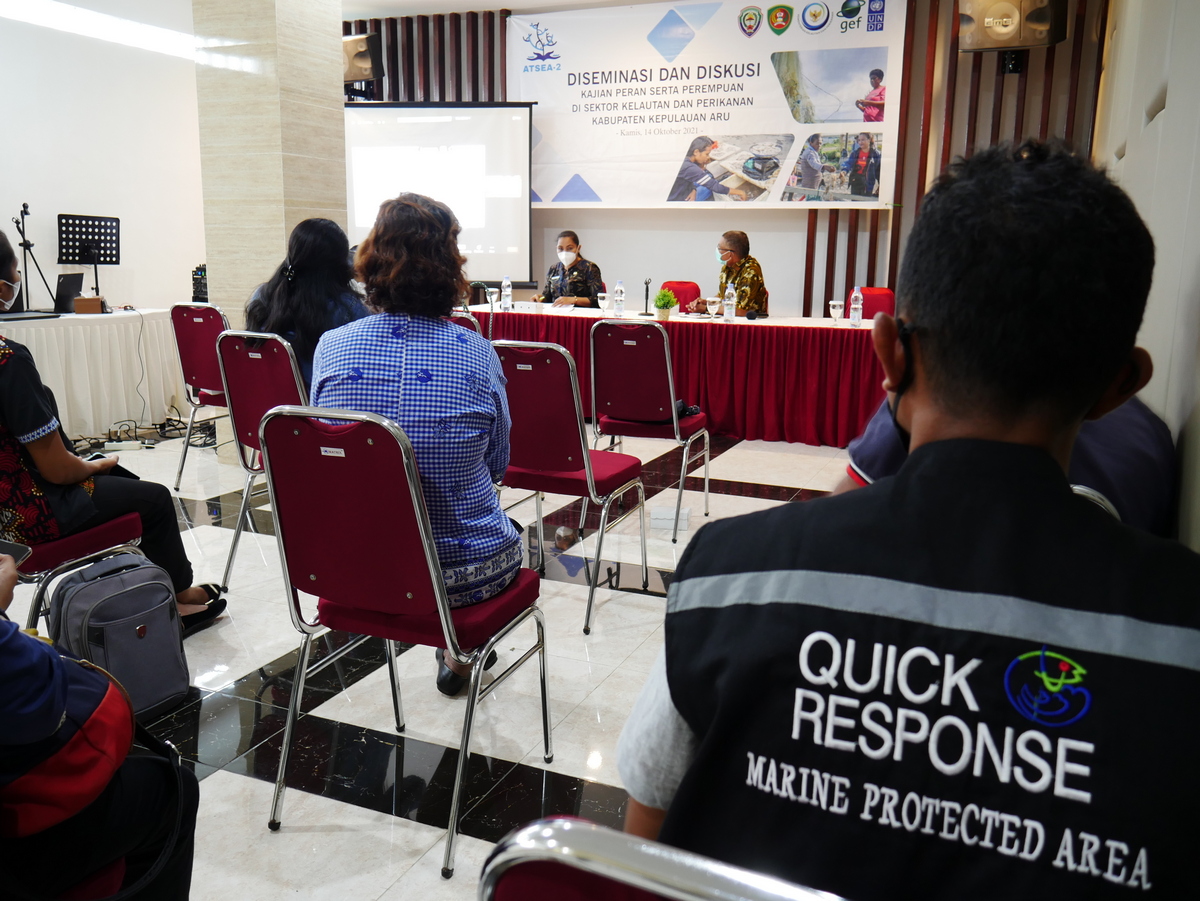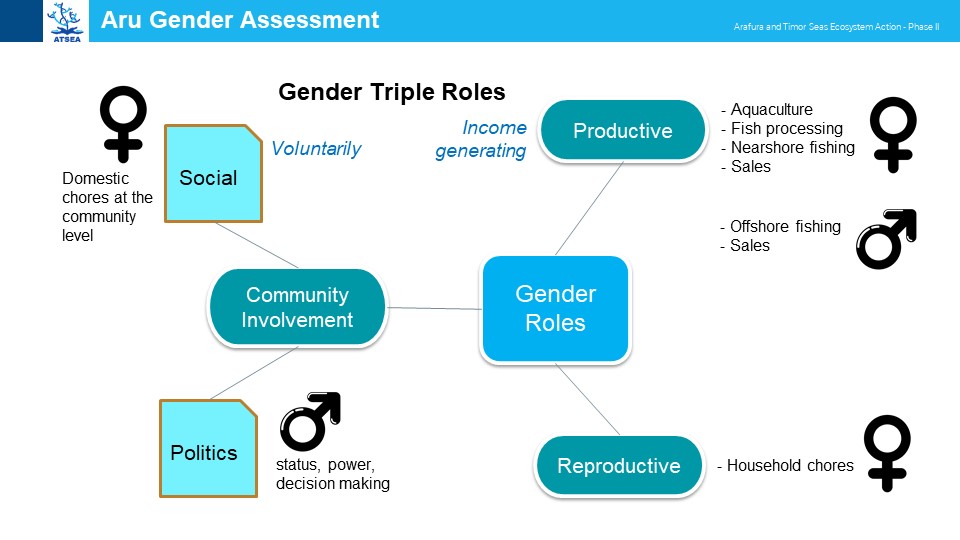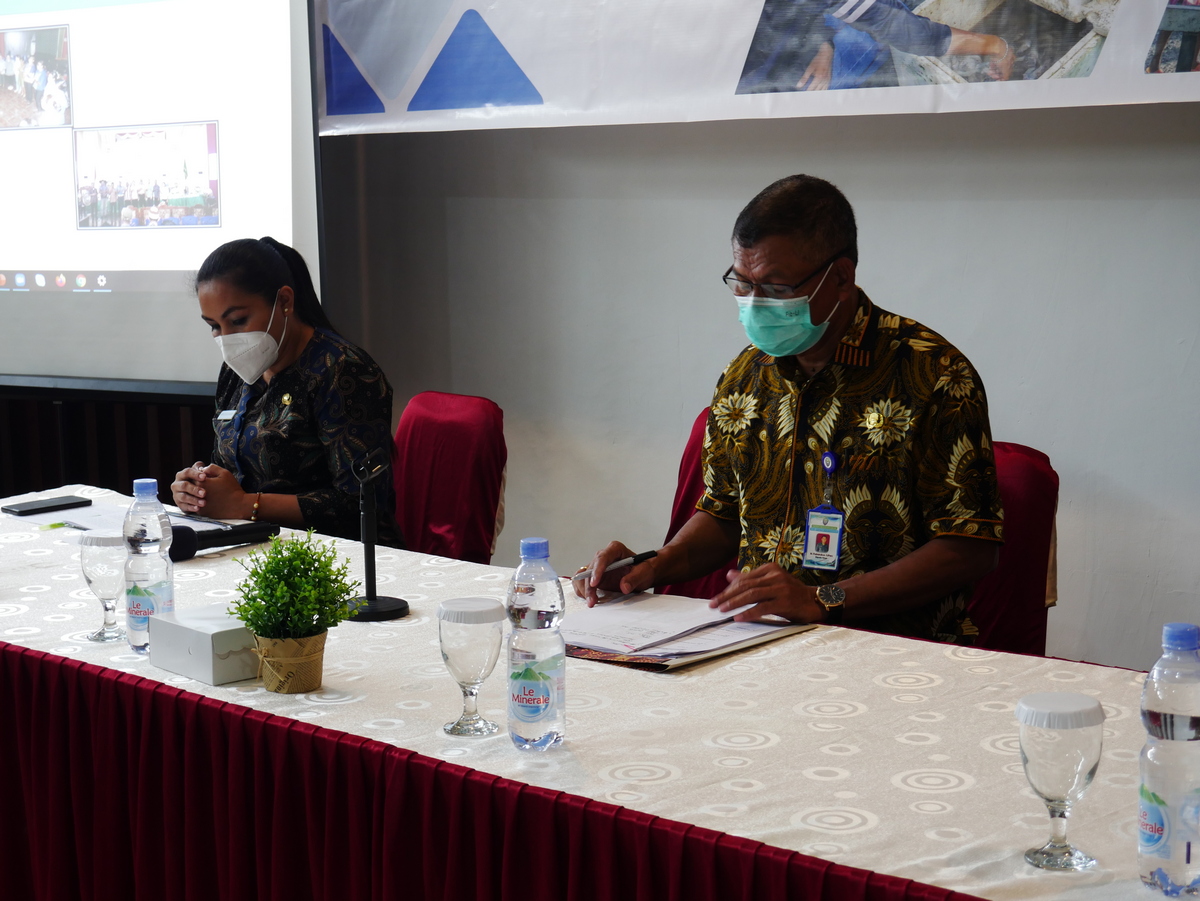This article was published on IW:Learn website
Women play an essential role in pre- and post-harvesting processes in the marine and fisheries sector. However, their contributions are often overlooked and undervalued, especially when it comes to making decisions. The ATSEA-2 Programme hosted a discussion involving a range of national- and local-level stakeholders, which encouraged women to voice their opinions and exercise their rights in marine and fisheries resource management.
The marine and fisheries sector is not immune to gender inequality, as men and women utilise marine and coastal resources in different ways. According to recent gender studies conducted in Aru district, there are many disparities between men and women. This includes their entitlement to capacity-building activities, their access to harvesting areas and, most importantly, their cultural expectations in relation to productive, reproductive and public roles. This has resulted in an imbalance of power relations; although women play a vital role in fishing activities, they are usually left out of the decision-making process. When it comes to marine and coastal resources management, in the customary management system, women’s voices are seldom heard.




As part of the ATSEA-2 Programme’s mission to promote gender equality in marine and coastal management, a gender study was conducted during April 2021 in five villages in Aru Island Regency. The study employed qualitative methods in the form of Key Informant Interviews (KIIs) and Focus Group Discussion (FGD) involving 71 women and 63 men who were relevant actors, stakeholders and authorities. The aim was to identify gender-related issues at the grassroots level and local social attitudes that contributed to these inequalities. Through this study, the ATSEA-2 Programme aimed to identify factors that contribute to the perpetuation of gender inequalities in the marine and fisheries sector in Aru and examine such factors through a gender perspective approach.
The analysis found that there was capacity segregation between men and women in several dimensions, including access to capacity building and different entitlement based on local practices or culture. More importantly, gender segregation was also evident in productive, reproductive and public roles, resulting in imbalanced power relations between women and men in accessing marine and fisheries resources, which also limited the ability of women to overcome discursive inequalities caused by climate change and environmental degradation. The study also discovered that gender issues in the fishing sector have been neglected and perpetuated for several reasons, including the perception of fisheries as a masculine domain, gender stereotyping of women’s physical condition as unsuited to fishing and voyaging at sea, and the belief that women are not technically astute in terms of the knowledge aspect of fisheries.
Following the results of the gender assessment in the Aru archipelago, in collaboration with the Ministry of Marine Affairs and Fisheries (MMAF), the ATSEA-2 Programme disseminated assessment results on 14 October 2021 at Eora Hotel Dobo in Aru Islands Regency. The discussion was attended by 15 representatives from the regional government of Aru Islands Regency, Maluku provincial government, the Ministry of Women Empowerment and Child Protection, the MMAF, the National Marine Conservation Area Agency of Kupang, Yayasan Sitakena, Yayasan TAKA and Destructive Fishing Watch (DFW) Indonesia. In addition, eight participants from the Centre for Fisheries Research and the Directorate General of Marine Spatial Management joined the discussion virtually.
“The Covid-19 pandemic has exacerbated gender disparity, as domestic chores are increasing and women become more vulnerable to this situation,” said Marthen Putnarubun, S.IPEM, Head of Women Empowerment and Child Protection Office of Aru Islands Regency. “This calls for all levels of society to work together to minimise the disparity,” he added. By involving relevant stakeholders at the national and local level to build linkages, the programme hopes to create a concrete action plan for future activities related to gender issues for marine and coastal programmes in Aru.
The ATSEA-2 Programme carried out gender assessment prior to programme commencement, in order to identify gender gaps and to better understand the situation in coastal fishing communities. This is considered an essential step, which should be replicated by other similar programmes. Another important point was raised with regards to synergising national and local officials in conducting complementary programmes. Furthermore, an emphasis was also placed on the importance of monitoring and evaluation to measure the relevance of the programme and its impact for key beneficiaries. Discussions also noted that implementation of a gender mainstreaming programme is not solely the responsibility of the women empowerment service office, but rather relies on the involvement of officials from all strategic sectors, because gender issues need to be approached through a coordinated and concerted effort among all related actors.
The discussion with key stakeholders also recommended extending and re-establishing the forum for women in the region, thereby helping them make their voices heard. The forum will provide women with access to civil society organizations and governmental authorities in the Aru district. Moreover, as an overarching goal, this activity also seeks to unite various customary groups, facilitating greater interaction and synergy between women’s groups from various other regions, so they can learn from each other.
As a follow-up action, the ATSEA-2 Programme plans to facilitate further discussions involving the MMAF and women empowerment officials at the national, provincial and local level in Aru, to tailor gender mainstreaming within each programme, including identification of shared roles and responsibilities. Through collaboration among these stakeholders, women in Aru will be encouraged to play a more prominent role in decision-making processes related to marine and coastal management, in line with the Minister of Marine Affairs and Fisheries Regulation No. 28/Permen-KP/2016.
Located in Indonesia’s Maluku Province, the Aru archipelago is home to more than 500 small islands. The ATSEA-2 Programme provides assistance in empowering women and improving the livelihoods of coastal communities in the southeast area of Aru (Aru Tenggara), where the region has been appointed as a Marine Protected Area (MPA) through the Minister of Marine Affairs and Fisheries’ Decree No.63/MEN/ 2009, dated 3 September 2009. Aru Tenggara MPA is under the management of Kupang National Marine Conservation Area Agency, with its work unit based in Aru.
(Laeli Sukmahayani)


